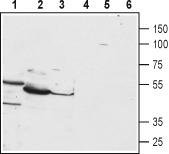Pth1r Rabbit Polyclonal Antibody
Other products for "Pth1r"
Specifications
| Product Data | |
| Applications | IHC, WB |
| Recommended Dilution | WB: 1:200-1:2000; IHC: 1:100-1:3000 |
| Reactivities | Human, Mouse, Rat |
| Host | Rabbit |
| Clonality | Polyclonal |
| Immunogen | Peptide (C)DAVLYSGFTLDEAER, corresponding to amino acid residues 241-255 of rat Parathyroid Hormone 1 Receptor . 1st extracellular loop. |
| Formulation | Lyophilized. Concentration before lyophilization ~0.8mg/ml (lot dependent, please refer to CoA along with shipment for actual concentration). Buffer before lyophilization: Phosphate buffered saline (PBS), pH 7.4, 1% BSA, 0.05% NaN3. |
| Purification | Affinity purified on immobilized antigen. |
| Conjugation | Unconjugated |
| Storage | Store at -20°C as received. |
| Stability | Stable for 12 months from date of receipt. |
| Gene Name | parathyroid hormone 1 receptor |
| Database Link | |
| Background | The parathyroid hormone receptor type 1 (PTHR1) is bound and activated by two peptide hormones: the parathyroid hormone (PTH) secreted by the parathyroid gland and by parathyroid hormone related peptide (PTHrP) which is produced locally in many tissues. Although these two peptides bind the same receptor, they exert different actions. PTH regulates the concentrations of Ca2+, phosphate ions and vitamin D in the blood, stimulates bone formation/resorption and is distributed to the kidneys where it regulates Ca2+ and phosphate transport, and is also detected in the liver. PTHrP, on the other hand, plays a critical role early in development of bone, heart, mammary glands and other tissues, and is detected in the circulation only during lactation and secreted by some tumors. PTHR1 is obviously localized to all areas and tissues where PTH and PTHrP are known to exert their effects (i.e. bone, kidney, blood, heart, etc.). PTHR1 belongs to the superfamily of G-protein coupled receptors. Like all members, PTHR1 has seven transmembrane spanning domains, an extracellular N-terminus and an intracellular C-terminal tail. Upon activation, the receptor couples to either Gs and Gq thereby activating adenylate cyclase and phospholipase C (PLC) respectively. In osteosarcoma cells, PTHR1 can also couple Gα. PTH is being used today to treat osteoporosis, as a factor promoting bone formation. Mutations in PTHR1 are associated with Jansen’s disease (hypercalcemia and dwarfism) and Eiken syndrome (cartilage tumors of bone). |
| Synonyms | MGC138426; MGC138452; OTTHUMP00000209970; OTTHUMP00000209971; PFE; PTHR; PTHR1 |
| Reference Data | |
Documents
| Product Manuals |
| FAQs |
{0} Product Review(s)
0 Product Review(s)
Submit review
Be the first one to submit a review
Product Citations
*Delivery time may vary from web posted schedule. Occasional delays may occur due to unforeseen
complexities in the preparation of your product. International customers may expect an additional 1-2 weeks
in shipping.






























































































































































































































































 Germany
Germany
 Japan
Japan
 United Kingdom
United Kingdom
 China
China




